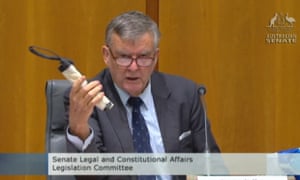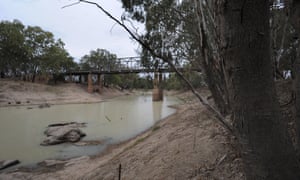Extract from The Guardian
The Liberals and Nationals are busy tussling over
water but they’re not the only ones. Irrigators, environmentalists
and communities all want their share. And as Bill Heffernan points
out, you can’t possibly please everyone

Senator Bill Heffernan brandishes a fake pipe bomb
during a committee hearing at parliament in May 2014. Photograph: AP
Contact author
Friday 16 October 2015 20.09 AEDT
Sometimes, just occasionally, a politician
deviates from their speaking notes or the carefully-calibrated party
line and calls bullshit on something important.
This week that’s what Liberal senator Bill
Heffernan did on water policy. Heffernan is often described as
“colourful” or “maverick” or other euphemisms for a bloke who
made a point about federal parliament’s security by brandishing
a fake pipe bomb in a committee hearing and about New South Wales
state parliament security by walking in (undetected) with
a knife with which he had personally castrated several hundred
calves.
This week’s contribution could be better
described as “on the money”.
As an
El Niño weather pattern approaches, and with it the likelihood
of another drought, the bitter divisions of water politics are
re-emerging – and with them the threat of ecological devastation,
the desperation of farm communities and South Australia’s
deep-seated fears about water supply.
This was all supposed to have been put to rest
with
the “compromise” on the Murray-Darling plan struck by former
Labor minister Tony Burke in 2011, calming the fury in regional
Australia which had seen the original version of the document
burnt on the main street of Griffith.
In fact these fears have been allegedly put to
rest so many times in the past few decades it’s hard to keep count.
Twenty-six years ago, as a cub reporter, I travelled with Bob Hawke
to Wentworth in far western NSW to hear him deliver what he modestly
referred to as “the world’s greatest environment statement”.
That involved spending $500m and planting 1bn trees, and marked the
first mainstream recognition that the over-allocation of farming and
irrigation water and general mismanagement meant things were going
terribly wrong with the nation’s most economically important river
system.
In 2004 the federal government and the states set
aside $1bn to “give back” 500 gigalitres (about one Sydney
Harbour full) of the over-allocated Murray-Darling water to the
environment. That didn’t work very well either, so in 2007 a new
water minister called Malcolm Turnbull put together a $10bn plan to
solve the problem, which was subsequently recast by the Rudd
government, with a $2.8bn top-up. Then came the 2011 plan. Now it,
too, is under pressure.
Like all truly difficult problems this is a fight
between genuine inter-related – but competing – interests.
The Darling river in Louth, New South Wales, in
2008. The southern Murray-Darling basin is forecast to suffer a 15%
decline in rainfall, equivalent to a 35% decline in runoff.
Photograph: Dean Lewins/AAP
On the environmental side, successive governments
had unquestionably over-allocated water rights in a way that was
proving fatal for the ecology. But how much water needs to be “put
back”? The CSIRO found 3,500 to 4,000 gigalitres at a minimum. The
draft Murray-Darling basin plan said 3,000 gigalitres. The final
compromise agreement, struck by Burke, said 2,750. Late last year, as
rural anger rose, the parliament legislated that a maximum of 1,500
gigalitres could be achieved through water “buybacks” , with the
rest coming from water saved by commonwealth spending on more
efficient water use by farmers or more efficient use for the
environment. It’s not clear that this is going to be possible.
And to complicate things further, from the outset,
politicians have been promising different things to different people.
Former prime minister Julia Gillard did a side deal with South
Australian premier Jay Weatherill to add another 450 gigalitres to
the 2,750 – adding $1.7bn to get that extra water and make sure the
mouth of the Murray was open 95% of the time. She also did a
side-side deal with Victoria and NSW that the extra 450 gigalitres
would be the subject of a review, which might reduce the
environmental water by 650 gigalitres. So voters in South Australia
were told the plan would deliver up to 3,200 gigalitres, while NSW
irrigators were told it was likely to be as low as 2,100. The
“review” is to be decided next year.
On the farming side the consequences and fears are
also dire.
The former Labor government bought back a lot of
water during the drought years, with some financially-distressed
farmers selling permanent water licences on the assumption they could
buy temporary licences in the future. With a drought looming, the
laws of supply and demand (and the many speculators in the largely
unregulated and unpoliced water market) are making those permits
unaffordable.
The Liberal backbencher and member for the
Victorian seat of Murray, Sharman Stone, says the buybacks are also
having knock-on effects, for example leaving so many dairy farms in
her region “dried out” and unproductive, that it is threatening
dairy manufacturing investment. She says the Murray-Darling is losing
$5m a day in food production because of reduced water availability.
Stone also wants the $1.7bn agreement with South
Australia revisited, saying some of that money might be better spent
just turning on Adelaide’s desalination plant.
The deep fears of rural communities are
percolating into the federal political process in other ways.
Water is now a live-or-die issue for the National
party, which is why it demanded the portfolio switch from the
environment minister to the agriculture minister (Barnaby Joyce) in
its Coalition agreement with Malcolm Turnbull. It also explains the
strange spat over Joyce’s formal job description, in which he
demanded his junior minister, South Australian Liberal senator Anne
Ruston, have no say over the day-to-day decision making on water.
One of Joyce’s first decisions will be whether
he accepts a recommendation in a recent review to ditch the
requirement that any money earned by the commonwealth from water
trading be spent on more buybacks, and whether he accepts demands for
the commonwealth to be able to sell “excess” water to irrigators,
increasing supply and reducing temporary water prices.
Environmentalists see those ideas as the thin end of the wedge, a
further erosion of the water available for the environment.
And pressure on the Nationals will only intensify
with a Senate committee instigated by the crossbench senators and
taking evidence throughout regional areas. Those senators are
championing a grassroots plea that the Murray-Darling plan be
“paused”, whatever that might mean.
And on top of those all those conflicting
interests, and the contradictory promises to different
constituencies, the
Murray-Darling basin plan didn’t take the impact of climate change
into account at all.
It was apparently one complication too many in
trying to resolve an already diabolically hard problem, so the plan
was based on historical averages of rainfall.
That is why the Wentworth
Group of Concerned Scientists rejected the plan, saying it was
based on the incorrect assumption that “there is no risk to river
health from climate change.”
Which brings us back to Heffernan.
Politicians, he said, had to stop making
contradictory promises they couldn’t keep. Promising everyone more
water was like promising everyone free beer, it only made you popular
until they realised you couldn’t do it. He cited figures suggesting
the southern Murray-Darling basin would suffer a 15% decline in
rainfall, equivalent to a 35% decline in runoff.
“The science is warning us” he said, and it
was time for politicians to stop making promises that really amounted
to playing politics with the people whose livelihoods depend on
Murray-Darling water, and also with the environment.

No comments:
Post a Comment